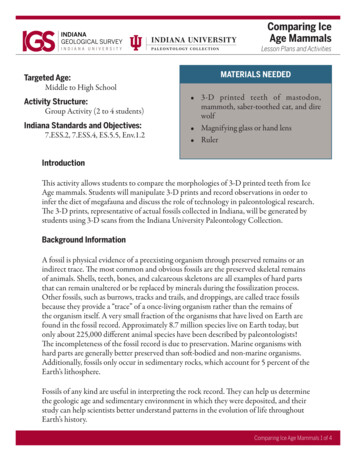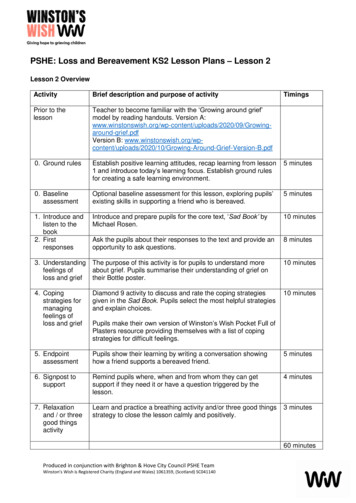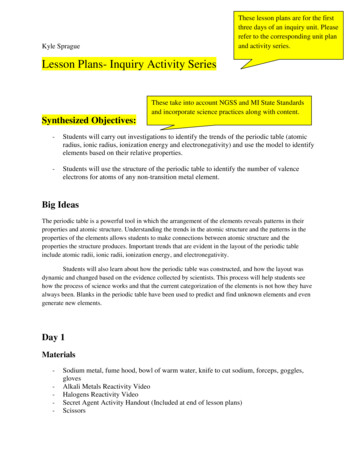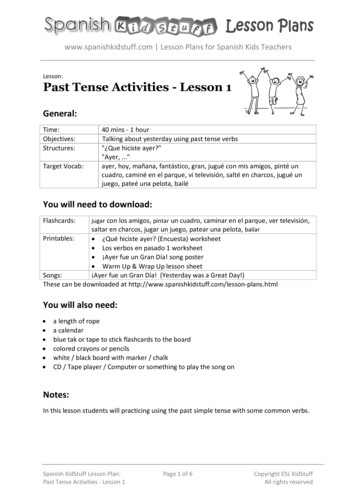
Transcription
Comparing IceAge MammalsLesson Plans and ActivitiesTargeted Age:Middle to High SchoolActivity Structure:Group Activity (2 to 4 students)Indiana Standards and Objectives:7.ESS.2, 7.ESS.4, ES.5.5, Env.1.2MATERIALS NEEDED 3-D printed teeth of mastodon,mammoth, saber-toothed cat, and direwolf Magnifying glass or hand lens RulerIntroductionThis activity allows students to compare the morphologies of 3-D printed teeth from IceAge mammals. Students will manipulate 3-D prints and record observations in order toinfer the diet of megafauna and discuss the role of technology in paleontological research.The 3-D prints, representative of actual fossils collected in Indiana, will be generated bystudents using 3-D scans from the Indiana University Paleontology Collection.Background InformationA fossil is physical evidence of a preexisting organism through preserved remains or anindirect trace. The most common and obvious fossils are the preserved skeletal remainsof animals. Shells, teeth, bones, and calcareous skeletons are all examples of hard partsthat can remain unaltered or be replaced by minerals during the fossilization process.Other fossils, such as burrows, tracks and trails, and droppings, are called trace fossilsbecause they provide a “trace” of a once-living organism rather than the remains ofthe organism itself. A very small fraction of the organisms that have lived on Earth arefound in the fossil record. Approximately 8.7 million species live on Earth today, butonly about 225,000 different animal species have been described by paleontologists!The incompleteness of the fossil record is due to preservation. Marine organisms withhard parts are generally better preserved than soft-bodied and non-marine organisms.Additionally, fossils only occur in sedimentary rocks, which account for 5 percent of theEarth’s lithosphere.Fossils of any kind are useful in interpreting the rock record. They can help us determinethe geologic age and sedimentary environment in which they were deposited, and theirstudy can help scientists better understand patterns in the evolution of life throughoutEarth’s history.Comparing Ice Age Mammals 1 of 4
The fossils used in this lesson represent animals that lived in Indiana during the Ice Age.Approximately 2.6 million to 10,000 years ago, during a time known as the PleistoceneEpoch, immense glaciers spread as sheets of ice over northern North America. Normalclimate fluctuations, caused by changes in the tilt of the Earth’s axis and its orbit aroundthe Sun, caused glacial ice to advance and withdraw several times. The severe climaticchanges had a major effect on the flora and fauna living in Indiana. Forests dominatedby deciduous trees (maple, beech, basswood, oak, and hickory) occupied Indiana duringperiods of glacial retreat. Glacial periods were dominated by coniferous trees such asspruce. Large mammals, such as mammoths, mastodons, saber-toothed cats, and direwolves, roamed the land south of the glacial margin. The most recent period of glacialadvance into the state occurred 30,000 to 15,000 years ago. Around 10,000 years ago,these megafaunal species disappeared during the transition from the Pleistocene toHolocene Epoch, an event geologists refer to as the Quaternary Extinction. In NorthAmerica, approximately 70 percent of mammals became extinct because of climatechange and human predation (including the four animals in this exercise). Today, thesegreat beasts are only recognized by their fossil evidence.The Indiana Geological Survey and Indiana University Paleontology Collection havepartnered to assist teachers in their teaching and understanding of fossils and ancientlife. The 3-D prints used in this activity were scanned from a real-life fossil found inIndiana, converted into a digital model, and replicated as a 3-D printed object. Theuse of 3-D prints in a classroom allows for authentic, real-world learning with tangibleobjects that would not otherwise be readily available to teachers and students. Digitizedfossil collections can be made accessible to the broader scientific community to enhancepaleontological research.VocabularyBrowser – a herbivore that feeds on leaves, soft shoots, or fruits of woody plants, such asshrubsCanine – pointed tooth between incisors and molars in a mammal, often enlarged incarnivoresCarnassial – blade-like cheek teeth of carnivorous mammals, which usually consists of apremolar and molarEpoch – a subdivision of geologic time that is shorter than a periodFossil – physical evidence of a preexisting organism through preserved remains or anindirect traceGrazer – a herbivore that feeds on grass or other low vegetationMegafauna – large or giant animalsMolar – grinding tooth at the back of the mouthMorphology – the shape and structure of an organismPaleontologist – a scientist who studies forms of preexisting life through fossilsComparing Ice Age Mammals 2 of 4
Teacher Reference PageMastodonScientific Name: Mammut americanumLived in Indiana: 400,000–10,000 years agoHabitat: Open spruce woodlandsDiet: Herbivore, browser, ate softvegetation like leaves and twigsTeeth: Short, straight tusks (upto 9 feet long). High-crowned,molar-shaped teeth(5 inches wide). Twoto four cone-shapedcusps covered inenamel used to mashleaves and twigs.Appearance:Weighed 4 to 6 tons(8,000–12,000 pounds). Flat, rounded forehead, lowshoulders, no fatty humps on neck or shoulders. Grew upto 10 feet tall at shoulder.MammothScientific Name: Mammuthus primigeniusLived in Indiana: 400,000–10,000 years agoHabitat: Grassland areasDiet: Herbivore, grazer, ate grassesTeeth: Long, curved tusks (sometimes over12 feet long). Large teeth (8 inches tall, 12inches wide). Closely spaced flat-crownedridges alternating withdentine and cement.Chewed grasses bymoving lower jawforward, down, andbackward in a grindingmotion.Appearance:Weighed 4 to 6 tons (8,000–12,000 pounds). High,peaked forehead, high shoulders, fatty humps on neck orshoulders. Grew up to 14 feet tall at shoulder.Saber-toothed CatScientific Name: Smilodon fatalisLived in Indiana: 500,000–9,400years agoHabitat: Margins of woodlands and brush plainsDiet: Carnivore, ateslow-moving animalsTeeth: Upper canineteeth are long (7inches), flat anddaggerlike, effective forpuncturing and slicingprey. Incisor teeth areconical and in a curved row. Shearing carnassial teeth,lower canines, upper and lower molars.Appearance: Weighed 350–620 pounds, larger thanlions and about the size of Siberian tigers. Front and backlimbs about the same length, muscular build, short tail.Body length 5.8 feet tail to snout, grew up to 3.3 feet tallat shoulder.Dire WolfScientific Name: Canis dirusLived in Indiana: 300,000–10,000 years agoHabitat: Woodland and plain areasDiet: Carnivore, specializations for meat eating. Ate largeprey (220–260 pounds), supplemented diet with smallermammals, birds, and berries.Teeth: Daggerlike canine teeth, greaterbite force than modern wolves. Cuttingblade on carnassial teeth, irregularbowl-shaped molars.Thickened mandiblebelow carnassial teeth.Appearance:Weighed 130–150pounds, larger thanthe Gray wolf, Redwolf, and Coyote.Proportionally larger front legs. Short limbs relative tobody mass, stocky build, long tail. Body length 4.1 feettail to snout, grew up to 2.6 feet tall at shoulder.Illustrations by Karen Carr, courtesy of the Indiana State Museum http://indianamuseum.orgComparing Ice Age Mammals 3 of 4
Procedure1. Distribute the fossil study sets and student data sheets to each group. Review thevocabulary terms and glacial history of Indiana prior to beginning activity.2. Instruct students to manipulate each fossil print. Students should measure thelength and width of each fossil and sketch the fossil in order to accurately reporttooth morphology.3. Instruct students to carefully record their observations on the student datasheets, making sure to include scale.4. Once students have observed the fossils, compare and contrast toothmorphology. Ask students to contrast the fossil prints to their own teeth,emphasizing the role of each tooth’s shape in their own eating habits.5. Ask the class what clues to diet are shown in the teeth. Students should recordtheir hypotheses on their data sheets, making sure to justify their answers withobservations.6. Allow students to review the activity through the reflection questions. Discusshow 3-D printing allowed them to make these observations.What clues to diet are shown in teeth? Ask studentsto observe fossil morphology in order to infer diet.Comparing Ice Age Mammals 4 of 4
Comparing Ice Age MammalsLesson Plans and ActivitiesName:Class Period:Vocabulary:MATERIALS NEEDED 3-D printed teeth of mastodon,mammoth, saber-toothed cat, and direwolf Magnifying glass or hand lens RulerBrowser – a herbivore that feeds on leaves, soft shoots, or fruits of woody plants, such asshrubsCanine – pointed tooth between incisors and molars in a mammal, often enlarged incarnivoresCarnassial – blade-like cheek teeth of carnivorous mammals, which usually consists of apremolar and molarEpoch – a subdivision of geologic time that is shorter than a periodFossil – physical evidence of a preexisting organism through preserved remains or anindirect traceGrazer – a herbivore that feeds on grass or other low vegetationMegafauna – large or giant animalsMolar – grinding tooth at the back of the mouthMorphology – the shape and structure of an organismPaleontologist – a scientist who studies forms of preexisting life through fossilsIntroductionThis activity allows students to compare the morphologies of 3-D printed teeth from IceAge mammals. Students will manipulate 3-D prints and record observations in order toinfer the diet of megafauna and discuss the role of technology in paleontological research.The 3-D prints, representative of actual fossils collected in Indiana, will be generated bystudents using 3-D scans from the Indiana University Paleontology Collection.Comparing Ice Age Mammals 1 of 5 - Student Copy
Student Reference PageMastodonScientific Name: Mammut americanumLived in Indiana: 400,000–10,000 years agoHabitat: Open spruce woodlandsDiet: Herbivore, browser, ate soft vegetation like leavesand twigsTeeth: Short, straight tusks (up to 9 feet long). Highcrowned, molar-shaped teeth (5 inches wide). Two tofour coneshaped cuspscovered inenamel usedto mashleaves andtwigs.Appearance:Weighed 4 to 6 tons (8,000–12,000 pounds). Flatter,more rounded forehead, lower shoulders, no fatty humpson neck or shoulders. Grew up to 10 feet tall at shoulder.MammothScientific Name: Mammuthus primigeniusLived in Indiana: 400,000–10,000 years agoHabitat: Grassland areasDiet: Herbivore, grazer, ate grassesTeeth: Long, curved tusks (sometimes over 12 feet long).Large teeth (8 inches tall, 12 inches wide). Closely spacedflat-crowned ridgesalternating with dentineand cement. Chewedgrasses by moving lowerjaw forward, down, andbackward in a grindingmotion.Appearance: Weighed4 to 6 tons (8,000–12,000 pounds). High,peaked forehead, high shoulders, fatty humps on neck orshoulders. Grew up to 14 feet tall at shoulder.Saber-toothed CatScientific Name: Smilodon fatalisLived in Indiana: 500,000–9,400 years agoHabitat: Margins of woodlands, brush plainsDiet: Carnivore, ate slow-moving animalsTeeth: Uppercanine teeth arelong (7 inches),flat and daggerlike,effective forpuncturing andslicing prey. Incisorteeth are conical and in a curved row. Shearing carnassialteeth, lower canines, upper and lower molars.Appearance: Weighed 350–620 pounds, larger thanlions and about the size of Siberian tigers. Front and backlimbs about the same length, muscular build, short tail.Body length 5.8 feet tail to snout, grew up to 3.3 feet tallat shoulder.Dire WolfScientific Name: Canis dirusLived in Indiana: 300,000–10,000 years agoHabitat: Woodland and plain areasDiet: Carnivore, specializations for meat eating. Ate largeprey (220–260 pounds), supplemented diet with smallermammals, birds, and berries.Teeth: Daggerlike canine teeth, greater bite force thanmodern wolves. Cutting blade on carnassial teeth,irregular bowl-shaped molars. Thickened mandible belowcarnassial teeth.Appearance:Weighed 130–150pounds, larger thatthe Gray wolf, Redwolf, and Coyote.Proportionally largerfront legs. Shorter limbs relative to body mass, stockybuild, long tail. Body length 4.1 feet tail to snout, grewup to 2.6 feet tall at shoulder.Illustrations by Karen Carr, courtesy of the Indiana State Museum http://indianamuseum.orgComparing Ice Age Mammals 2 of 5 - Student Copy
Student Data Sheet1. Assign a letter for each fossil print. Measure the width and length of each fossil andrecord your data below.FossilWidth (cm)Length (cm)ABCD2. Observe each fossil carefully and sketch its shape in the spaces below. Make detailedobservations of the tooth morphology. Include scale using your measurements from above.Fossil AFossil BFossil CFossil DComparing Ice Age Mammals 3 of 5 - Student Copy
3. Make an inference of each animal’s diet based on its tooth morphology. Complete thetable below and justify your answers using observations of fossil morphology.DietFossilHB – Herbivore, browserHG – Herbivore, grazerC – CarnivoreEvidence & ObservationsABCD4. Use your Reference Sheet to identify each megafauna species based on its fossil tooth.Draw a line to match the inferred diet of each fossil tooth to the scientific name.FossilDietScientific NameAHGMammut americanumBCMammuthus primigeniusCCSmilodon fatalisDHBCanis dirusComparing Ice Age Mammals 4 of 5 - Student Copy
Reflection Questions1. What type of fossil preservation is represented by the 3-D models: unaltered hardparts, mineralized hard parts, or trace fossils? Explain your answer.2. While all megafauna fossils are rare, mastodon teeth are themost prevalent in Indiana. Why are there relatively few knownfossils of Ice Age mammals?Hint: think about geographic diversity versus the fossilization processFigure 1: Mastodon jawbonediscovered in Rensselaer, Indiana3. What happened to Ice Age mammals once human migrationspread into North America? What other factors could havecontributed to the megafaunal extinction at the end of thePleistocene Epoch?Figure 2: Here, a staff member is3-D scanning the mastodon jawboneusing a Creaform GoScan 504. What are the basic characteristics of herbivore teeth? Carnivoreteeth? Give an example of a special adaptation for each.Figure 3: Complete 3-D scan ofmastodon jawbone5. How can scientists use 3-D printing to enhance paleontological research?Hint: think about discoverability and sharing ideas with scientists around the globe.Indiana Geological Survey Indiana University611 N. Walnut Grove Ave., Bloomington, IN 47405-2208 812.855.7636 info@indiana.edu igs.indiana.eduComparing Ice Age Mammals 5 of 5 - Student Copy
the geologic age and sedimentary environment in which they were deposited, and their study can help scientists better understand patterns in the evolution of life throughout Earth’s history. Comparing Ice Age Mammals 1 of 4 Comparing Ice











